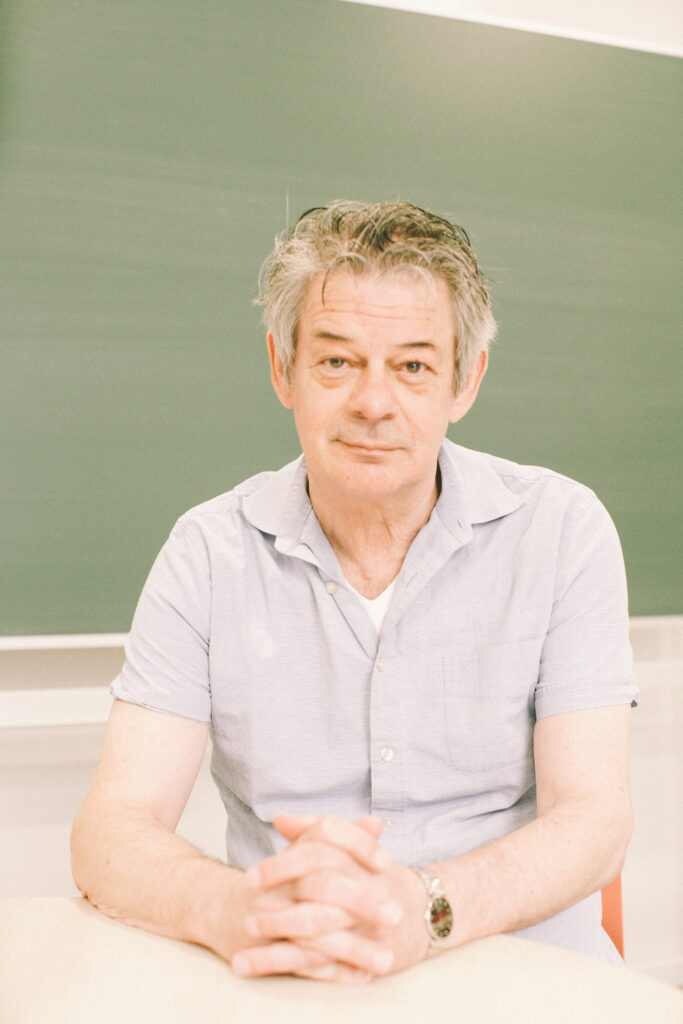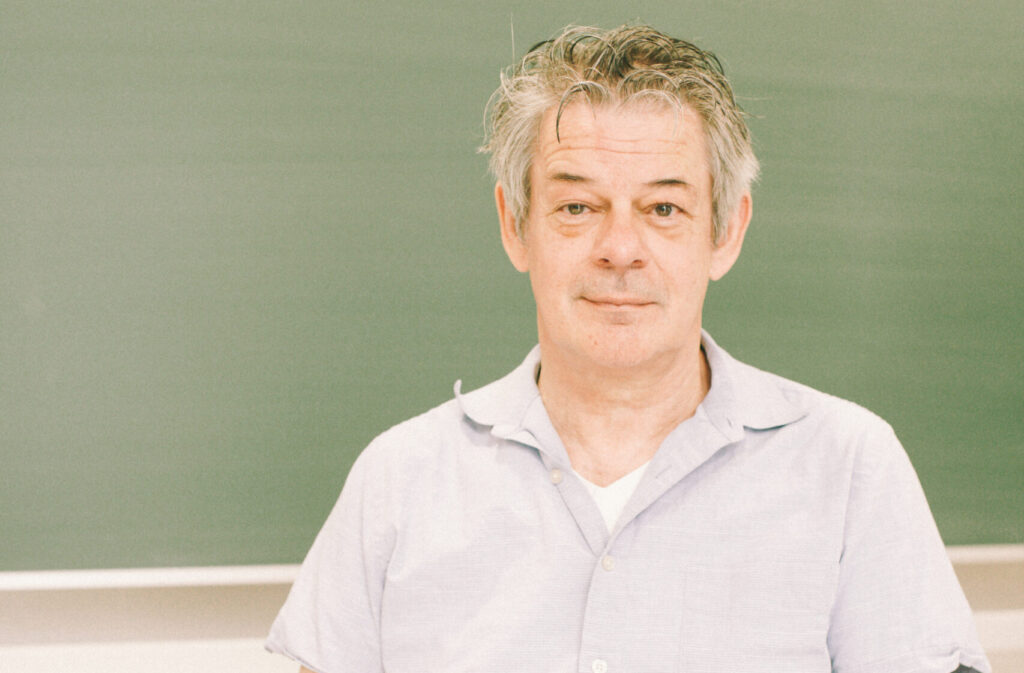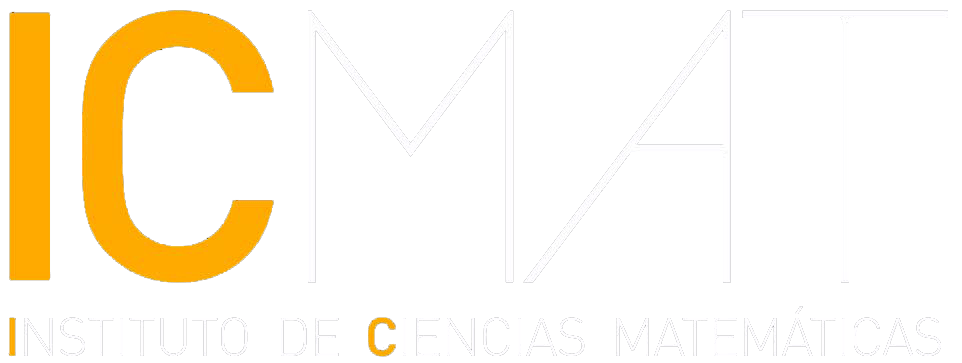Interview: Alan Reid (Rice Universit), co-director with Martin Bridson of one of the new Severo Ochoa Laboratories program

Alan Reid is an expert in low-dimensional topology, hyperbolic varieties and geometric group theory. Image: Iñigo de Amescua / ICMAT
Low-dimensional topology is a fundamental area in mathematics due to the unique properties that emerge in these spaces, which are not found in higher dimensions. For example, in three dimensions, knots and manifolds reveal complex phenomena that do not have an analog in other dimensions. Additionally, this field has direct applications in physics, especially in quantum field theories, string theory, and relativity, where understanding the structure of space-time is crucially dependent on three-dimensional topology and geometry. In low dimensions, topology and geometry are strongly interconnected, as William Thurston intuited – which culminated years later in the proof of Grigori Perelman’s geometrisation conjecture–.. Thurston is one of the major influences on Alan Reid, who, along with Martin Bridson, is co-director of one of the new Severo Ochoa Laboratories program. The Scottish mathematician has been a professor and has been the chair –since 2018– of the Department of Mathematics at Rice University (USA). In addition to his contributions to low-dimensional topology, Reid has achieved influential results in hyperbolic manifolds and geometric group theory.
Question (Q): Could you present the topics that the ICMAT Lab focuses on?
Answer (A): They can be grouped under the umbrella of interactions between low-dimensional geometry and topology, geometric group theory, and profinite groups. Specific focal points will include profinite rigidity and the development of a structural theory for finitely generated parafree groups. These groups, introduced by Gilbert Baumslag in the 1960s, have gained prominence recently through the work of Andrei Jaikin-Zaparain (ICMAT-UAM), who has connected them to the still-open question of Vladimir Remeslennikov regarding whether the free group is profinitely rigid.
Q: Why have you decided to lead this program?
A: The research interests of the faculty forming the group at ICMAT align well with those of Bridson and myself. The timeliness of many topics to be discussed, such as profinite rigidity, is also noteworthy. Recently, Bertrand Rémy delivered a Bourbaki seminar on this topic, titled ‘Géométrie des groupes et complétion profinie, d’après Martin Bridson, Alan Reid et al.’ at the Institut Henri Poincaré (Paris) in March 2024.
“ICMAT’s research interests align closely with those of Bridson and myself, especially in profinite rigidity.
Q: What results or impact would you like it to have?
A: We would like to use this as an opportunity to expose graduate students and junior researchers to new and exciting developments in fields that are presently very research active. Of course, we would be incredibly pleased if over the course of the Lab, we were able to answer Remeselennikov’s question.
Q: Can you describe your research interests briefly?
A: My research interests have always centered around the connections between number theory, geometry, and topology. This focus is particularly evident in the study of three-dimensional manifolds. One of William Thurston’s –a mathematician who revolutionized the field of low-dimensional topology and geometry– key insights is that certain topological conditions on a 3-manifold can guarantee the existence of a geometric structure on it. If a geometric structure doesn’t exist, then the manifold can be decomposed into simpler pieces, a process influenced by rigidity phenomena.
Q: What do you mean by rigidity?
A: In dimension 2, when you look at surfaces like a sphere or a genus, they’re quite flexible—you can stretch and change their geometry. But in dimension three and higher, it is often the case that this flexibility disappears; these structures become rigid, almost like little diamonds. In any class or category of objects one might work with, there are these ‘diamonds’ that stand out, and our goal is to find them in the darkness and identify their various properties. This kind of rigidity has deep connections with number theory in powerful ways. The interplay between rigidity, number theory, symmetry, and group theory has been at the core of nearly all my work. If I had to choose two words that encapsulate my research, they would be symmetry and rigidity.
Q: And if you want to encapsulate it in an object?
A: It would be the complement of the figure eight knot in the 3-sphere. It turns out to have the structure of a hyperbolic manifold, which is a geometrical condition on the manifold. This is an example of what Thurston said: topological conditions on a manifold imply geometrical conditions. This figure eight knot complement has been pervasive all my academic career, I have studied it a lot for various reasons, and I still think about it.
Q: What is your relationship with William Thurston?
A: He is one of the individuals who significantly influenced my mathematical direction. Although I didn’t interact with him extensively, our encounters were meaningful enough to deeply influence my ideas, way of thinking, and approach to problems—his perspective was truly revolutionary.
“Thurston’s revolutionary ideas deeply shaped my approach to mathematics”
Q: Other than him, which scientist has impressed you the most during your career?
A: I’ve also been greatly influenced by colleagues with whom I’ve co-authored papers, such as Darren Long, a British mathematician based at UC Santa Barbara. We’ve published 43 papers together, which represents a serious commitment from both of us! He was also the best man at my wedding and is a very dear friend. Martin Bridson [co-chair of the Laboratory, President of the Clay Mathematics Institute and the Whitehead Professor of Pure Mathematics at the University of Oxford] is another influential figure in my career. There are also people from very different mathematical and cultural backgrounds with whom I’ve connected in powerful ways, like Alex Lubotzky [Professor of Mathematics at the Hebrew University of Jerusalem, Israel]. When I was at University of Texas at Austin, I worked alongside John Tate [Abel Prize 2010] and Karen Uhlenbeck [Abel Prize 2019], and even though they weren’t in my specific area, their approach to mathematics was highly influential. Besides, collaborating with new, younger mathematicians has also played a significant role in my development. It’s hard to name everyone, but I feel incredibly lucky to have met and worked with all these remarkable people.
Q: What is your relationship with Martin Bridson?
A: I first met Martin in 1990 when he was a graduate student at Cornell and I was a postdoctoral fellow at Ohio State University. We had many similar mathematical –and non-mathematical– interests and over the course of the years, we would exchange emails and meet at conferences. Our collaboration really started in December 2009 when we were both visiting New Zealand and we –and our families– stayed at Gaven Martin’s house for the Christmas holidays. He is a mathematician at Massey University. We started discussing questions about profinite rigidity of Fuchsian groups, and this eventually led to our first paper –with Marston Conder, of the University of Auckland–. Since then we have collaborated –sometimes with others– and published seven papers in total, with one more paper under review, and several other projects in various stages of completion (or not!). It has been an incredibly rewarding experience to work with Martin over the years.
Q: How important is collaboration in mathematics? What you’re saying doesn’t really match the stereotype of the solitary mathematician, working by his own in an ivory tower…
A: Historically, that image was quite accurate. Even when I was younger, mathematics was a more solitary discipline. However, that began to change with the advent of the internet and email. With almost instantaneous communication, we can now write and edit papers simultaneously. Today, collaboration has become the norm for most people.
Q: And beyond virtual, remote collaboration, what would you say the value of physical meetings is to this discipline?
A: Being in a place like ICMAT, not just for a conference but for an extended stay, offers something very tangible and visceral that we all missed during the pandemic. Even though we could connect via Zoom, personal interaction—fostering new collaborations or bringing fresh ideas to old problems—seems to happen much more effectively in a face-to-face setting, one person to another. There’s a lack of understanding about how mathematicians interact and how crucial social interaction is for mathematical creativity.
Q: Could you give an example?
A: I recall an instance when I gave a talk at a conference, and afterward, Ian Agol [former director of an ICMAT Lab, professor at the University of California, Berkeley, and 2016 Breakthrough Prize in Mathematics] approached me. We chatted, and he suggested some ideas that turned out to be absolutely spot on, leading us to co-author a paper. This kind of spontaneous collaboration happens frequently, and it’s a vital part of how mathematics evolves.
Q: Speaking of papers… Which recent results in your field would you highlight?
A: My interests are quite broad and I would highlight several that I particularly like. Firstly, “Arithmeticity, superrigidity, and totally geodesic submanifolds” (Annals of Math. 193, 2021) by Uri Bader, David Fisher, Nicholas Miller and Matthew Stover. In this paper the authors provide a positive answer to a conjecture that the structure of totally geodesic sub manifolds of finite volume hyperbolic manifolds characterizes arithmeticity of these manifolds. The proof is a remarkable application of ideas from Gregory Margulis’s proof of super rigidity.
Secondly, “Hyperbolic 5-manifolds that fiber over S^1“ (Invent. Math., 2022) by Giovanni Italiano, Bruno Martelli and Matteo Migliorini. In this article the authors provide examples of finite volume cusped hyperbolic 5-manifolds that fiber over S^1. One consequence of this is that they are able to provide an answer to a question of Mikhael Gromov: There is a hyperbolic group G that contains a subgroup H of finite type –i.e., it is the fundamental group of a finite aspherical cell complex– that is not hyperbolic. In particular, they also show that there is a finite type group H that is not hyperbolic and does not contain any Baumslag – Solitar subgroup BS(m,n).
Finally, a paper of your own Andrei Jaikin-Zapirain [ICMAT-UAM, codirector of the Laboratory]: “The finite and soluble genus of finitely generated free and surface groups” (2023). This is great interest to me right now, as in this paper Andrei proves –roughly– that groups with the same finite quotients as a free group are so-called parafree groups, invented by Gilbert Baumslag back in the 1970’s. The question of whether the free group is determined by its finite quotients is an old question of Vladimir Remeslennikov, from the 1970’s, to which we referred at the beginning of the conversation. Andrei’s result provides the first real structure to groups that might have the same finite quotients as a free group. There has been a lot of activity on this question recently, and the ICMAT held a workshop in 2023 that brought together many of the experts who have been at the cutting edge of these subjects.
Q: Which specific mathematical problem do you consider particularly challenging?
A: Recently, I’ve been thinking a lot about profinite rigidity. If you have an infinite group, how would you study it? To what extent can you distinguish your group from all other groups? From my background, I’m interested in groups that act on objects, such as vector spaces or finite sets. This approach gives you finite groups as quotients of the ambient group. By examining the list of all these quotients obtained from actions on finite sets, can you distinguish the original group? This is the same Remeslennikov question, in its entirety, not just for free groups.

Alan Reid is co-director, with Martin Bridson (University of Oxford, UK), of one of the new Severo Ochoa programme laboratories. Image: Iñigo de Amescua / ICMAT
Q: Which subjects in mathematics outside of your field would you like to learn more about?
A: Some of my work connects with number theory and the theory of automorphic forms. I’d really love to have time to go more deeply into this area, and in particular work surrounding the Langlands program.
Q: Why did you choose mathematics over any other subject?
A: In school, I was interested in and performed well in various subjects. I went to university with the intention of studying Physics, but it quickly became apparent that I found the math lectures more interesting, stimulating, and enjoyable, while I wasn’t particularly fond of the experimental aspects. The transition to studying math felt natural.
Q: How was your first experience with mathematical research?
A: When I finished my BSc, I stayed in Aberdeen for my PhD and during the summer I went to visit my PhD advisor to chat. He gave me a book on Algebraic Number Theory and said “Read this and do as many exercises as you can before September!” Although this was in some sense similar to undergraduate work, it felt different in that to me at the time, it felt like the first steps doing research.
Q: What did you enjoy most about your early experiences with mathematical research?
A: It’s a combination of factors. First and foremost, I loved the subject. From the very moment I began doing research, it was clear this was what I wanted to do. It doesn’t feel like just a job to me. I feel incredibly privileged to be in a position where I can come to a place like ICMAT, surrounded by exceptionally talented, gifted, and creative individuals from diverse backgrounds and cultures—some of whom I know well, and some I know less well—and simply be inspired.
Q: While visiting the ICMAT, what aspects of the institute and the environment would you highlight the most?
A: First, it’s the people. I’ve known some of the researchers for quite a while. I’ve known Javier since he was a graduate student, and his research is close to my initial background. I also know Oscar García-Prada, Andrei Jaikin, and Yago Antolin, and I enjoy talking with all of them. ICMAT is a remarkable institution, and the Agol Lab and the Hitching-Ngo Labs have been significant attractors for mathematical research. The openness of the institution to hosting outside visitors is fantastic. Martin Bridson and I spent a week here in 2019, and we worked on something that eventually led to a publication. We acknowledged ICMAT in that publication because our ability to come here and collaborate was crucial. Although it might be difficult to quantify, being able to visit such places and interact with collaborators and new people is incredibly valuable.
“The openness of ICMAT to hosting outside visitors is fantastic”
Q: You have included a diversity statement from Chris Leininger on your website. Could you kindly share some thoughts on the current state of diversity within the mathematical community?
A: There is still a long way to go. There are many areas where we could improve. While some progress has been made, and there is a growing awareness among the mathematicians I interact with that we need to do more, the situation is still far from ideal. It has been disappointing to see a slight decline in the number of women entering the field in the U.S., even as we emphasize the need for improvement and strive to make the community more welcoming. As someone who has chaired various math departments, I am acutely aware of the need to support diversity, inclusiveness, and equity in the community. My home institution, Rice University in Texas, is working hard to improve conditions for women and underrepresented minorities, but it’s a difficult situation. We must continue to work incredibly hard to address these issues.
“Despite progress, there’s still a long way to go in achieving diversity and inclusiveness in mathematics
Q: Besides mathematics, what other activities do you enjoy the most?
I like to play tennis, and really should try to find the time to play more. My first love as a child was to play football, and I continue to follow football keenly; particularly my hometown team Buckie Thistle, as well as the fortunes of Aberdeen and Manchester United. When I was a child I probably didn’t dream about winning the Fields Medal but probably had dream about playing football for Scotland.
